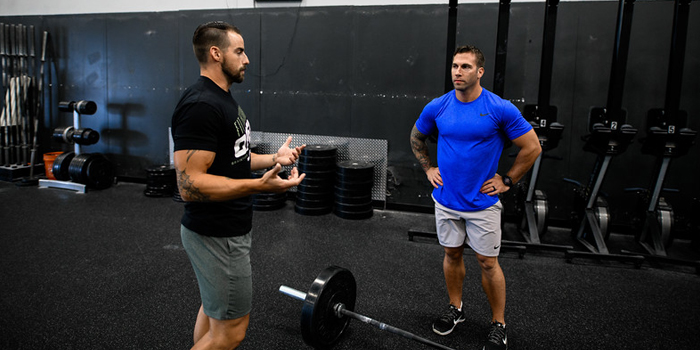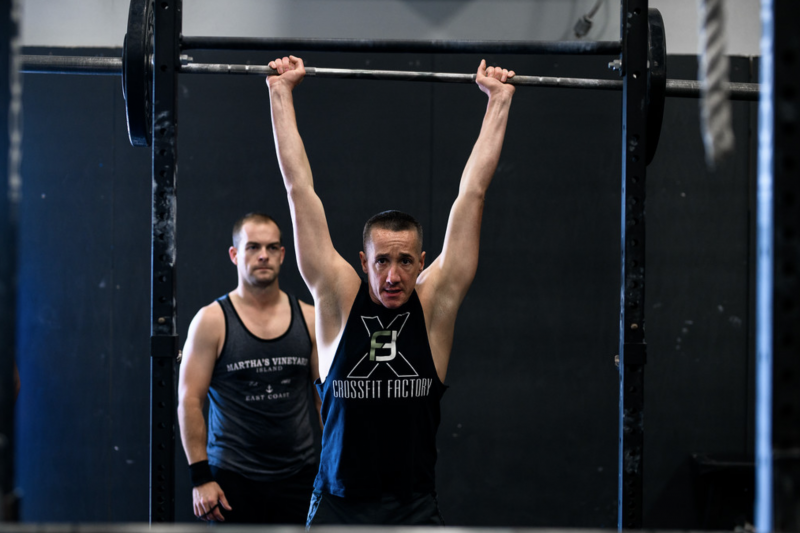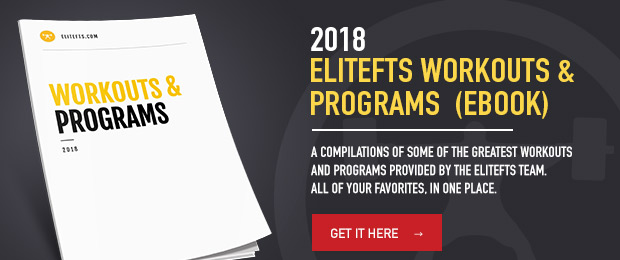
Over the last 10 years, I've seen many changes in the relationship people have with box programming. If you've been doing box programming for at least five years, your relationship, too, may have changed from what it once was when you first started.
Out of those OG box athletes, the sheer number of Kool-Aid drinkers has shrunk significantly, and many have moved on to other forms of training. From a business standpoint, I've seen an influx of boxes close this last year compared to past years.
In terms of my personal relationship with box programming, it has changed quite a bit over the last few years. It went from “I'd train harder and harder trying to push my limits” to simply feeling burnt-out and broken. The lack of motivation that followed from the classic 21-15-9 was palpable.
This brought me to the conclusion a few years ago that I'd stop performing any movements that caused me pain. Seemed like a novel idea, right? Not tough workout pain, either; legitimate pain that keeps you up at night and sucks the motivation out of you.
Most coaches tell their clients to avoid movements that cause them pain, but why do so many not heed this advice? It's simple: ego. Your friend is performing the WOD as prescribed and doesn't want to be left behind on the gains-train.
Interestingly enough, when this shift took place in my own training and the less-is-more approach became my mantra (performing about 10 sessions a week versus about four sessions a week), I incurred the most success with my fitness that I've ever had as well as the most success I've ever had in the Open.
This is what really poured gas on the fire of this less-is-more epiphany. It was crazy to think that 10 sessions yielded significantly fewer results than four sessions — not to mention the all-important motivation factor — this was a critical piece of information that I had to share with my clients, and that sparked even more research.

This is the first year since 2011 that I'm not taking part in the Open. Originally, it was because we are having our third child the week the open starts, and in addition to taking a full course load of graduate classes for my masters in exercise science as well as running a business, I simply didn't want to add anything else on to my plate.
But if I'm being honest, those were really just excuses. The honest answer is that I simply have zero drive to put myself through workouts that don't align with my goals anymore, as well as sacrifice my body to perform movements that cause me pain. My college strength coach always used to say, "It's not the one gust of wind that breaks the branch on the tree — it's the years of wind. Eventually, there is a breaking point."
I've heard the same sentiment from more than a few of my friends that have been doing box programming for a decent length of time — many of them now attend a commercial gym.
A lot of the topics that are going to be touched upon in this article are ones I've talked about numerous times before, here and here, so most of this may not come as shock to you.
If you're a client, you've seen everything we are going to talk about within our system of group program design executed on the regular.
What Needs to Change
Since starting to take on the programming of hundreds of boxes worldwide four years ago, I've made it my mission to promote the things that I KNOW people need. Unfortunately, what people need is not necessarily what people want — this is where the biggest challenges lie when trying to challenge the norms of functional fitness.
RELATED: General Criteria to Consider When Writing a Program
This involved programming less of many things that box athlete purists include on the regular, like high-volume gymnastics variations, training the same patterns multiple days in a row, and not following any type of cohesive plan.
Higher-skill work that injures people has always taken a back seat in my programming, and as you can imagine, this is where we sustain the most pushback from gym owners and their clients.
But I'm perfectly okay with that because if things don't change, boxes will continue to lose clients — for myself, I may attract fewer clients in the short-term to this system — but eventually, people will have to get smarter if they want to sustain their businesses.
We can no longer go against the laws of biology or biomechanics. We need to rely on science and what we do know about the human body and not forget the psychology behind the way we program.
We also need to assume that our clients are already stressed out from their everyday lives and know that more intensity isn't going to be the answer.

And if we're trying to actually serve our clients and needs goals at the highest level, our programming must align with those goals.
Where to Start
Have a plan: Random programming is novel at first and may work for a while, but it will NOT work forever. Have a plan in terms of how your work is structured within the week to ensure proper distribution of movement patterns and separation of high-intensity work. If you go with overhead daily and/or squatting daily, ask yourself how you feel training like that. Also, if you plan things correctly, it shouldn't matter what days people show up — they'll still receive work that will move them forward.
Use low-skill work to drive high-skill work: Build clients’ foundations with copious amounts of strength work favoring unilateral work versus bilateral work as well as work that everyone can perform despite their training age.
Use lower-intensity work to drive high-intensity work: Look, our lives are stressful, and compounded stress on stress is a recipe for burnout. Instead, the basis of our conditioning should be lower-intensity work.
Add more strength work: Strength is the foundation of ALL fitness, not to mention it serves the NUMBER ONE GOAL of all arguably every person that walks through your door: improve how they look and feel. Moreover, this work will greatly decrease the risk of injury when they are ready for higher-skill work, giving them a solid foundation of strength FIRST.
READ MORE: Two Crucial Components Your Training is Missing
Drop high-volume gymnastics: 100 C2B pull-ups may have their place for the box competitor, but it does NOT have a place for a soccer mom. Instead, give your clients an option that aligns with their goals, like more weekly horizontal pulling.
Avoid Olympic lifting: Much like high-volume gymnastics, Olympic lifting will have little effect on your clients' overall goals and will drastically increase the risk of injury when consistently performed in conditioning work. If someone wants to focus on the Olympic lifts, then it should be done in a specialty class or in a one-on-one training session, not in a conditioning piece when their heart rate is at 180.
Increase the frequency of loaded carries and sledwork: Most boxes seldom program loaded carries or sledwork. If there were a single modality that provides a huge bang for their buck, why would you not use it regularly? Additionally, this work carries low-skill requisite and no axial loading, making it a no-brainer. This fits perfectly into our low-skill work to drive the high-skill work model, as this work checks the boxes on multiple areas.
Put less emphasis on scores or times: For the type A person (as most of those who are drawn to box programming tend to be), constantly measuring themselves against others and their past performances can be detrimental to their mental health, especially when people incur setbacks from stressors outside of the gym that can impair how they're performing on a given day. I'm all for keeping track of data, but mixing in scoreless workouts that focus on quality versus quantity can go a long way.
Spend more time developing the basic squat, push, and hinge movement patterns: High-skill gymnastics and the Olympic lifts require huge investments of time to improve. The question is could you spend your clients’ time better with something else? The answer is yes. Instead, aim to turn your clients into technicians when it comes to squatting, pushing, and hinging.
In Summary
Everything that has been mentioned serves as the core values of our group program design. I'm not saying completely abandon everything about box programming—what I'm saying is, structure your plan around modalities that address your core clients’ needs and goals.
If your program design does not align with your clients’ needs and goals and you're letting your clients dictate what goes on the whiteboard, then be prepared for an increased rate of injury and burnout. Like that branch on the tree breaking, it may not happen right away, but believe me, it will happen.
Overall, as a community, we need to be smarter. We need to think about the long-term goals of our clients as well as the long-term goals of our business and know that most people don't care about competing in the sport of fitness. Will your clients still be training at your facility in three years? Five years? Ten years?
Photo credit courtesy of @rx.photography











Your model seems the most sustainable for all modes of fitness but the strength bias is always tough to sell to people due to old ways of thinking it seems...
Kind of rambling but hope that makes sense!
Thanks for the content. It’s given me a lot of ideas and guidance.
coincidentally, my father-in-law is a radiologist for the Military. He said he sees an insane amount of CrossFitters with jacked-up shoulders, knees, hips and backs. In a lot of cases it results in that member being med boarded (kicked out) due to the seriousness of their injuries. Most of these injuries were sustained 2 or 3 years prior too.
I don't see any Military members doing CrossFit any more, not saying that they don't exist, I just don't see them.
I like to say it’s not what you do in training but how your body adapts to it, or better yet as Louie Simmons says “ Train optimally not maximally.”
I’m very impressed watching you grow as an athlete, coach, and mostly as a person over all these years.
I'm not referring to one box, I'm referring to CFHQ methodology, what they preach in their seminars, and what happens in the vast majority of the 15,000 gyms. Of course, like anything some gyms are better than others and this isn't the case for everyone, but I've found after working with nearly 500 boxes in the last 5 years are that the ones that have zero strength and conditioning background and their only exposure to training coming from CF have no clue about basic principles of exercise physiology which explains a lot in terms of the program design.
Recently listened to the Chasing Excellence podcast where Ben Bergeron says the total opposite about strength bias programming. He says it cannot be the main piece and having the star be strength is disservicing your clients.
So many differing views on this subject.
Thoughts? We all know BB is connected to some big names in CF, so perhaps he is biased to elite athletes as opposed to us regulars?
I like the idea of the unilateral work and strength and have found myself outside he Cf box and working more in my basement due to the lack of interest in classic Cf.
Thanks so much! I'm glad you brought up the viewpoints of BB. First off, I'm not even sure how this debate can be made if we can consider the actual facts and adaptations that occur from strength work. I do think context is crucial though in terms what is classified as "strength work." I rarely see BB use strength measures outside of the barbell. Only using a barbell for strength work is like only using a hammer for every task around your house - eventually you need other tools to accomplish the task at hand. Additionally, clients that have come from their program to ours all complain of the same thing - their athletes not getting stronger and becoming rundown. Coincidentally his program still asks these same people that haven't developed any strength to perform heavy bilateral movements in a fatigued setting which is a great way to injure people.
Second, if we consider the goals of nearly every person that walks into a box it involves things like looking better and feeling better. Strength work is the vehicle for those goals, not conditioning. The cumulative training effects of strength work align BEST with these goals. To be clear, our strength work includes things that also have an "aerobic effect" like sledwork, loaded carries, but also includes regular doses of dumbbell work geared developing hypertrophy. Additionally, this work is "easy" to perform and requires little skill which really allows us to guarantee the adaptations we are looking for as well as encompass the needs of more people in a group setting.
In our system using a concurrent approach via the Conjugate Method - all modalities our prioritized so it's not say conditioning (particularly oxidative systems work) is not made a priority, it is. This model is rather complex in terms of delivering all modalities in a weekly plan though and many coaches simply refer to textbook models of concurrent training and miss the boat.
Lastly, when you're working with a model athlete like a games athlete their limiting factors still need to be addressed and I can't help but wonder where things like special exercises fit into their plan, but these athletes are definitely outliers - guys like Rich Froning train at a level that in reality is not feasible for the human body as far as handling those amounts of stress regularly.
Hope that helps. Thanks for reading!